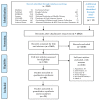Association between Harmful and Addictive Perceptions of E-Cigarettes and E-Cigarette Use among Adolescents and Youth-A Systematic Review and Meta-Analysis
- PMID: 36360406
- PMCID: PMC9689130
- DOI: 10.3390/children9111678
Association between Harmful and Addictive Perceptions of E-Cigarettes and E-Cigarette Use among Adolescents and Youth-A Systematic Review and Meta-Analysis
Abstract
Background: Recognising the association between the perceived risks of e-cigarettes and e-cigarette usage among youth is critical for planning effective prevention and intervention initiatives; thus, a systematic review and meta-analysis were performed.
Methods: Fourteen databases were searched for eligible studies from the Inception of database until March 2022 to examine the effect estimates of the association between perceptions of harmfulness and addictiveness and overall e-cigarette usage among adolescents and youth.
Results: The meta-analysis showed that in comparison to non-users, young people who were ever e-cigarette users were two times more likely to disagree that e-cigarettes are harmful (OR: 2.20, 95% CI: 1.41-3.43) and perceived e-cigarettes as less harmful than tobacco cigarettes (OR: 2.01, 95% CI 1.47-2.75). Youths who were ever e-cigarette users were also 2.3 and 1.8 times more likely to perceive e-cigarettes as less addictive (OR: 2.28, 95% CI: 1.81-2.88) or perceive e-cigarettes as more addictive (OR: 1.82, 95% CI: 1.22-2.73) than tobacco cigarettes, as compared with non-users. The subgroup analysis reported that adolescents were more likely to believe that e-cigarettes are less harmful than tobacco cigarettes, while youth users perceived otherwise.
Conclusion: the risk perceptions of e-cigarettes are associated with e-cigarette use among adolescents and youth and could be the focus of health promotion to prevent and curb the uptake of e-cigarettes among young people.
Keywords: addictive; adolescent; e-cigarette; harmful; risk perception; young people; youth.
Conflict of interest statement
The authors declare no conflict of interest.
Figures








References
-
- Collins L., Glasser A.M., Abudayyeh H., Pearson J.L., Villanti A.C. E-Cigarette Marketing and Communication: How E-Cigarette Companies Market E-Cigarettes and the Public Engages with E-cigarette Information. Nicotine Tob. Res. Off. J. Soc. Res. Nicotine Tob. 2019;21:14–24. doi: 10.1093/ntr/ntx284. - DOI - PMC - PubMed
Publication types
LinkOut - more resources
Full Text Sources

